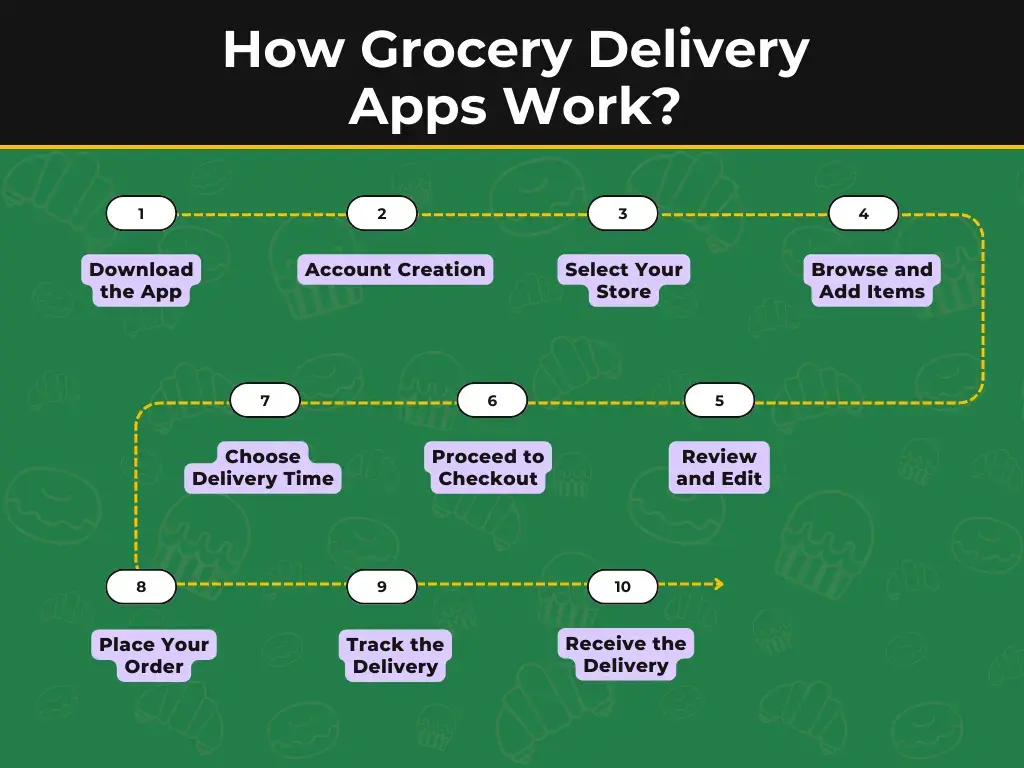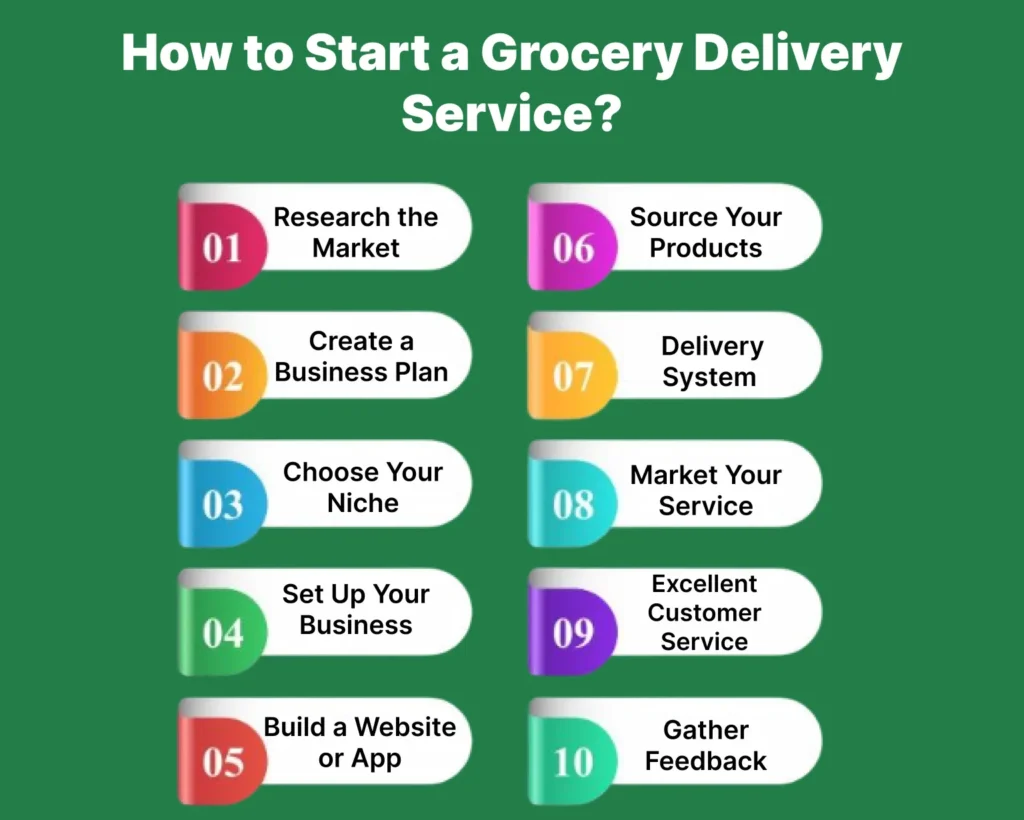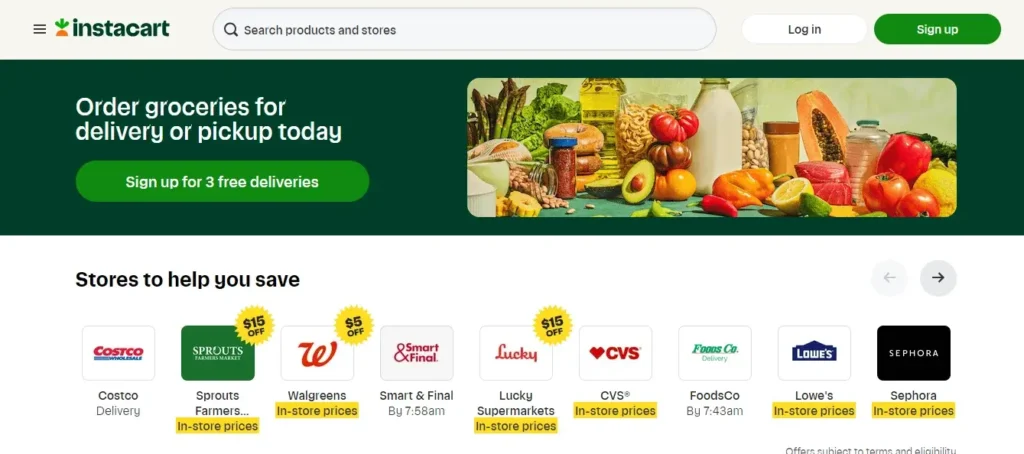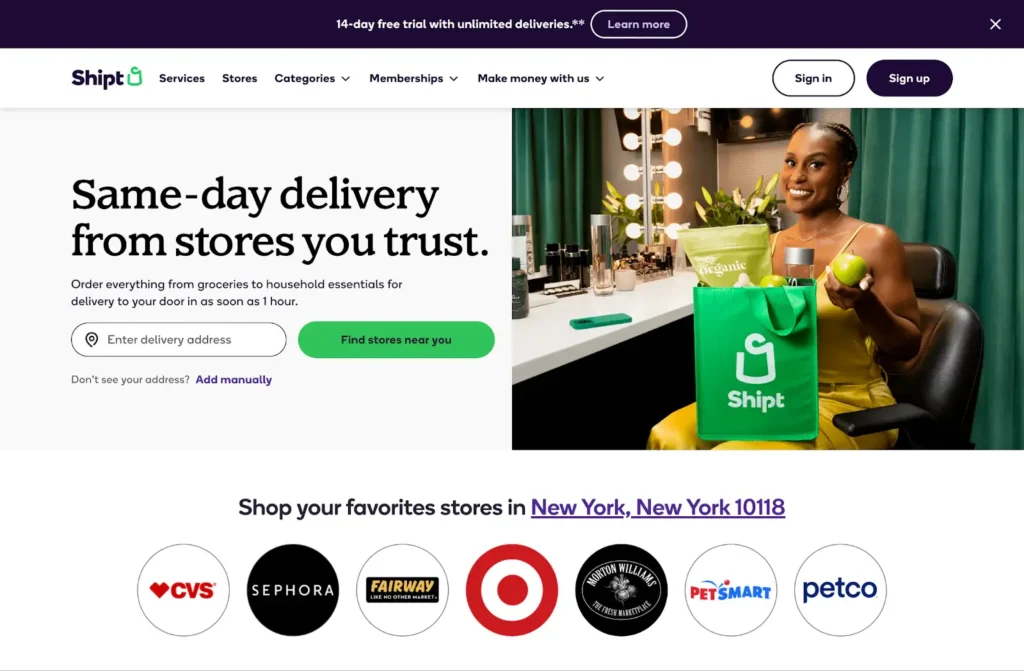
Key Takeaways
- The grocery delivery app market is growing, projected to reach $2,159 billion by 2030.
- Popular business models include Single-Store and Aggregator apps.
- Depending on features and complexity, development costs range from $42,000 to $250,000+.
- Key features include order tracking, multiple payments, and push notifications.
- Overcome challenges like delivery logistics and inventory management with tech solutions.
- Revenue streams include delivery fees, subscriptions, and partnerships.
Are you thinking about building the next Instacart or Gopuff? With more people turning to online platforms for their daily essentials, the grocery delivery app market is no longer a niche; it has become the new norm.
Whether you’re a startup founder, tech entrepreneur, or a local store owner ready to go digital, launching a grocery delivery app is a strategic move that can pay off big. But where do you start?
From choosing the right business model to understanding development costs and essential features, this blog guides you through everything.
Let’s explore the entire process of building a successful, user-friendly grocery app in 2025 that can help you position yourself at the forefront of this growing market.
What is a Grocery Delivery App?
The grocery delivery app is a digital platform that allows users to order groceries online from available stores and have them delivered to their doorstep. The grocery app offers advantages to both users and service providers, such as:
- Make the entire operation easily manageable
- Users can get all the things under one platform
- Businesses can get real-time updates
- Convenient and time-saving
- Cost-effective
Statistics of Grocery Delivery Apps
- According to GlobeNewswire, by 2030, the grocery delivery market is expected to reach $2,159 billion.
- In the grocery delivery market, the average revenue per user (ARPU) is expected to reach US$546.12 in 2025, according to Statista.
- In 2024, Instacart was the most downloaded mobile application for grocery delivery in the United States.
Grocery App Business Models
Below are two models in which grocery apps are developed.
Single-Store Model
To supply its items, a company develops an online delivery app. The size doesn’t matter in this case; it could be a tiny store with only one location or a nationwide chain.
| Pros | Cons |
| Low operational costs | Dependence on a single location |
| Direct control over quality | Higher delivery costs per item |
| Faster decision-making | Limited reach and scalability |
Aggregator Model
A business distributes the goods of several of its suppliers in partnership. In this model, the app acts as a platform to link customers with multiple stores simultaneously.
Consider Instacart; the company is only in charge of item delivery and promotion; the products in their catalogs are provided by different third parties.
| Pros | Cons |
| Wider selection | Limited control |
| Cost-effective | Potential for hidden fees |
| Increase visibility |
Revenue Models of a Grocery Delivery App
The main revenue models of a grocery delivery app are:
| Revenue Models | Description |
| Delivery Charges | Customers pay a fee based on distance, order value, or delivery speed. |
| Service Fees | A small percentage (5–15%) is added to each order to cover platform operations. |
| Store Commission | Partner stores pay a commission (10–25%) on every order placed through the app. |
| Subscription Plans | Users pay a monthly or yearly membership fee for free or discounted deliveries. |
| In-App Advertising | Brands pay for sponsored listings, featured products, or banner ads. |
| Surge Pricing | Delivery fees increase during peak hours, holidays, or high-demand periods. |
Step-by-Step: How Grocery Delivery Apps Work?
The working of an on-demand grocery delivery script app is simple. It involves some steps, such as:

Download the App
Users must download the app onto their mobile phone or tablet.
Account Creation
Open the app and create an account by providing the required information, such as your name, email address, and phone number. Some apps may also require your delivery address for accurate service.
Select Your Store
Once logged in, browse the available options and select your preferred grocery store from the list provided within the app.
Browse and Add Items
Search for specific items or browse through various categories. When you find a desired grocery item, tap on it to add it to your virtual shopping cart.
Review and Edit
After adding items to your cart, review the list to ensure you have everything you need. You can edit quantities or remove items if necessary.
Proceed to Checkout
When you’re satisfied with your selection, proceed to the checkout stage. Here, you’ll review the total cost of your order, including any applicable taxes, service fees, and delivery charges.
Choose Delivery Time
Select a suitable delivery time slot based on the available options provided by the app.
Place Your Order
Confirm your order and make the necessary payment through the app. Once the order is successfully placed, you’ll receive an order confirmation along with an estimated delivery time.
Track the Delivery
Many grocery apps provide real-time tracking features, allowing you to monitor the progress of your order.
Receive the Delivery
Finally, the delivery rider will arrive at your specified address and deliver your groceries to your doorstep.
Supercharge your deliveries with Enatega.
Launch NowKey Features of Grocery Delivery App Solution
Below are the main features of the grocery delivery application.

Manage Profile
The store owners will register by creating their profiles. They can manage everything from managing orders to monitoring reviews, and so on.
Order Scheduling
Order scheduling is the main feature that makes customers happy. With the app’s scheduling feature, customers have the option to book the date and time at which they want their order delivered.
Order Tracking
Live tracking of orders to keep users and grocery store owners informed about the status of their deliveries. Real-time order tracking keeps customers informed about how far their delivery is. With this feature, there is no misunderstanding between users and stores.
Search Functionality
This feature helps users find their specific products. They can easily search by using the filtering bar instead of scanning through thousands of products. It makes it easier for people to quickly get what they want.
Multiple Payment Gateway Options
The grocery app offers several payment options, such as digital wallets, credit/debit cards, and net banking, etc. Users can pay using their preferred methods.
Cash-on-delivery option is also available for customers who prefer to pay physically when they receive the ordered products.
To make shopping at your grocery store more convenient, you may also let customers pay for several orders in advance, particularly for recurring orders.
Push Notifications
The push notifications keep users aware of new products, deals, promotions, rewards, and more. With this feature of the app, the customers are engaged with your brand.
Additionally, grocery store owners can send targeted messages directly to customers. They give reminders about orders they have placed or provide suggestions for similar products based on their previous order history.
Live Chat
This feature of grocery ordering app development solution is a great way to keep customers happy. With the live chat feature, customers can get answers related to any item, order tracking, delivery time, and more.
Rating System
The rating system is a powerful tool for customers to rate their experience. Customers can check ratings before ordering; it can help them make an informed decision and spend money wisely.
With the ratings, businesses can know what improvements they have made in their business, which in turn produces better future experiences for their customers.
How Grocery Delivery App Development Benefits Your Business?
Here are some advantages of building an on-demand grocery delivery app.

- Revenue Generation
Generate revenue through delivery fees, subscription models, and partnerships with local grocery stores. Easily implement loyalty programs and discounts to retain customers.
- Optimize Productivity
The custom grocery app development saves time for retailers, users, and platform owners. It streamlines all the tasks and reduces manual efforts. Retailers can efficiently receive, process, and fulfill orders without extensive paperwork.
- Market Opportunities
Reach a wider audience by providing a convenient solution for their daily needs. By staying ahead of the curve and continuously improving your service, you’ll keep your audience engaged and satisfied.
- Data Analytics
Use data analytics to understand user behavior, preferences, and popular products. You can make informed decisions to enhance the app’s features and services.
- Time-Saving
Developing the grocery app can save you time from developing the app from scratch. It is a pre-built solution that has great features, and you can easily launch your delivery app in no time. With time-saving and cost-effectiveness, you can quickly reach your target market.
How to Create a Grocery Delivery App?
When you start the on-demand grocery delivery app development, you need to do some planning and preparation.
Here is a step-by-step guide to help you build a top-notch delivery grocery app.

1. Market Analysis
Before starting to develop the app, conduct in-depth research and learn everything about your competitors, their strengths, weaknesses, and current market trends.
When you do your competitor research, you need to cover these things:
- What are the gaps that you fill with your app?
- What features do you need to include in your app?
- What is your target audience’s interest?
Doing a deep competitor check can help you find answers to the above questions.
2. Select the Features
Now, it’s time to select the app features. Carefully add the features by keeping your business needs and user interests in mind. List down the features in order of priority.
3. Choose the Tech Stack
Select the appropriate technology stack based on your app’s requirements and scalability goals. Consider factors such as server infrastructure, database, and programming languages.
4. Create UI/UX Design
Create the wireframes and prototype to visualize the app flow and functionality. Make sure that the app design is user-friendly, which improves the overall user experience.
5. Start Development
This step involves app development. Divide this step into two phases, which include both front-end and back-end coding to bring the app’s design to life.
Frontend Development
- Build the user interface based on the UI/UX designs.
- Implement a responsive design to ensure compatibility across devices.
Backend Development
- Develop a robust backend system to handle user accounts, order processing, and inventory management.
- Implement secure and scalable server architecture, ensuring data protection and efficient performance.
6. Testing
Conduct thorough testing to remove any issues and bugs. Try to make an app that is free from errors, and users can easily use it without any issues.
How to Start a Grocery Delivery Service?
Starting a grocery delivery service involves some steps, which include:

1. Research the Market
Look for grocery delivery services in your area. Find out what they offer and see if something is missing that you can provide.
2. Create a Business Plan
Write down your goals, target customers, and how you will make money. A clear plan will guide you as you start.
3. Choose Your Niche
Decide on the type of groceries you want to deliver, like organic foods, local products, or specific diets.
4. Set Up Your Business
Pick a catchy name for your service. Register your business and check what permits you need to operate legally.
5. Build a Website or App
Create a simple website or app where customers can easily order groceries. Make sure it has good pictures and descriptions.
6. Source Your Products
Find trustworthy suppliers or local grocery stores to get your products. Quality items will keep customers happy.
7. Plan Your Delivery System
Decide if you will do the deliveries yourself or hire drivers. Plan the best routes to save time and fuel.
8. Market Your Service
Promote your service using social media, flyers, and local ads. Offer discounts to attract new customers.
9. Provide Excellent Customer Service
Respond quickly to customer questions and concerns. Make sure deliveries are on time and customers are satisfied.
10. Gather Feedback
Ask customers what they think about your service. Use their suggestions to make improvements and grow your business.
Factors that Affect Grocery App Development Cost
The grocery delivery app development cost depends on several factors, such as:
Features
The number of features plays an important role in calculating the cost of the delivery app. The more features you add, the more development hours you need to spend on your project.
Number of Platforms
The development cost of a delivery app depends on the number of platforms you want for your app. They include Windows, iOS, and Android.
Tech Stack
The technology stack also determines the cost based on your project requirements. Keep in mind that ongoing maintenance and updates will also contribute to the overall cost of the app over time.
Complexity
It can be less expensive if you want a simple application with just a few features and screens.
How Much Does It Cost to Build a Grocery Delivery App?
The table below shows the estimated cost of building the grocery app development solution.
| Cost Component | Estimated Cost Range (USD) |
| Market Research | $5,000 – $15,000 |
| UI/UX Design | $5,000 – $20,000 |
| Backend Development | $10,000 – $50,000 |
| Frontend Development | $10,000 – $40,000 |
| Features Implementation | $15,000 – $100,000 |
| Testing and QA | $5,000 – $15,000 |
| Deployment | $1,000 – $5,000 |
| Maintenance & Updates | $1,000 – $5,000 per month |
| Marketing | $5,000 – $50,000 |
| Total Estimated Cost Basic/Medium App: $42,000 Advanced App: $250,000+ | |
How Long Does it Take to Build a Grocery Delivery App?
The table below shows the estimated timeline to build an on demand grocery delivery app development solution.
| App Type | Development Time |
| Basic Grocery App | 2–3 months |
| Mid-Level Grocery App | 4–6 months |
| Advanced Grocery App (Instacart-like) | 6–10 months |
| Fully Custom Enterprise App | 10–14 months |
| MVP (Fast Launch) | 6–10 weeks |
Popular Grocery Delivery Apps
Below are some popular grocery apps that help you create your own app.
Instacart

Instacart is a grocery delivery and pick-up service in the United States and Canada. Customers can order same-day delivery or pickup from more than 300 retailers and grocers.
Instacart generated $3.3 billion in revenue in 2023, according to Business of Apps. With the Instacart clone app, you can get groceries delivered to your door in as fast as 30 minutes.
Walmart

Walmart is among the biggest merchants in the world with 10,623 locations worldwide. It has 4,615 locations in the US. From Walmart, users can order food, clothes, household appliances, and even furniture. It makes the ordering process easy and convenient for those who prefer to order online.
Users can use an advanced filtering system to quickly find what they need and track their orders’ progress in real time.
Shipt

Shipt is another major name in the grocery delivery market. It is similar to Instacart and is based on the aggregator model. Users can order everything from groceries to household essentials for delivery to their door on the same day.
Challenges for Building the Grocery Delivery App
Building a grocery app involves several challenges, but with careful planning and implementation, these challenges can be overcome.
Here are some common challenges and their potential solutions.

Inventory Management
Challenge: Managing real-time inventory updates, ensuring accurate stock levels, and avoiding out-of-stock situations.
Solution: Implement an inventory management system that integrates with the app. Use barcode scanning and automatic stock updates to ensure accurate inventory information. Set up alerts for low stock levels and establish relationships with multiple grocery suppliers to minimize out-of-stock situations.
Efficient Delivery Logistics
Challenge: Optimizing delivery routes, managing multiple orders, and ensuring timely deliveries.
Solution: Use smart routing algorithms to optimize delivery routes based on factors like distance, traffic, and order priority. Integrate GPS tracking to monitor delivery personnel and provide real-time updates to customers. Implement a system that allows batch processing of orders to minimize delivery time.
Variety of Products
Challenge: Managing a wide range of grocery products with different sizes, weights, and perishability.
Solution: Categorize and classify products to simplify the ordering process. Implement search and filter functionalities to help customers find specific products easily. Collaborate with grocery store partners to ensure accurate product descriptions, images, and availability.
Scalability
Challenge: Building a grocery delivery app clone that can handle increasing user demand and scale to accommodate a growing customer base.
Solution: Design the app with scalability in mind, using cloud-based infrastructure and scalable databases. Regularly monitor system performance and optimize code to ensure efficient resource utilization. Conduct load testing to identify and address potential bottlenecks.
Retaining Customers
Challenge: Customer retention is another main challenge that businesses face.
Solution: Offer discounts and deals to customers. In addition, implement personalized features that make the app interesting and encourage customers to use it more.
Supercharge your deliveries with Enatega.
Launch NowFAQs
1. What are the pros of grocery delivery?
The main pros of grocery delivery service are:
- Save time
- Get the food from your favorite restaurant at any time
- Save gas
- Take advantage of deals
2. What are the 5 steps of developing an app?
Below are the steps for developing the app.
- Analysis and planning
- Select features
- UI/UX design
- Start development
- Testing
- Deployment
3. What is grocery delivery software?
The grocery delivery software provides groceries from the stores to the customer’s doorstep. Using the grocery delivery software, the users can easily get groceries from multiple stores without hassle.
4. Why do grocery stores have apps?
Below are some benefits that show why grocery stores have used and created apps for their business.
- Time-saving
- Cost-effective
- Provide better services to customers
- Improve management
- Expand customer base
5. What is the most-used grocery delivery app?
Instacart is the most used grocery delivery app that delivers food, drinks, household items, and more across the US.
6. Are grocery delivery services worth it?
Yes, grocery delivery services can be worth it for the convenience and time-saving they offer.
7. Who uses grocery delivery services the most?
Many people use grocery delivery services to conveniently get their favorite groceries from the stores they love and have them delivered right to their door.
8. Which grocery delivery service is cheapest?
Here is a list of the cheapest grocery delivery services.
- Walmart
- Amazon Fresh
- Kroger
9. Is grocery delivery profitable?
Grocery delivery can be profitable, especially in urban areas with high demand. However, it often faces challenges like high operational costs and competition, which can impact overall margins. Success depends on factors like pricing, efficiency, and customer retention.
10. What is the highest-paying grocery delivery service?
Instacart and Amazon Flex are often considered among the highest-paying grocery delivery services. Both offer competitive pay rates and flexible scheduling options.
11. How do grocery apps make money?
Below are some ways that demonstrate how grocery apps generate revenue.
- Delivery and service fees
- Membership subscriptions
- In-app advertising
- Get commission on each sale
- Markups on grocery prices
12. What is the future of grocery delivery apps?
The future of grocery delivery apps is likely to see:
- Increased automation
- Personalized shopping experiences through AI
- Enhanced sustainability practices
13. How long does it take to develop a grocery delivery app?
Developing a grocery delivery app takes 4 to 6 months, depending on factors like complexity, features, and the development team’s experience. Additional time may be needed for testing and iterations.
14. What is the cheapest way to develop an app?
The cheapest way to develop an app includes:
- MVP Approach: Start with a Minimum Viable Product to test core features.
- Freelancers: Hire freelance developers instead of a full-time team.
- No-Code/Low-Code Platforms: Use platforms for simpler apps.
- Open Source Solutions: Use open-source frameworks to reduce costs.
- Outsource: Consider offshore development teams for lower labor costs.
15. What is the best grocery delivery app to make money?
The best grocery delivery apps to make money include:
- Instacart: Offers flexible opportunities for shoppers and drivers, with potential for tips.
- Shipt: Focuses on same-day delivery and provides competitive pay for shoppers.
- DoorDash: Expanding into grocery delivery, it offers delivery drivers various earning options.
16. What is the best grocery app development company?
Enatega is the best grocery app development company. They have a proven track record in building grocery or on-demand delivery apps.
Conclusion
Developing a grocery delivery app development is a strategic move to grow online. To succeed in this market, you need a robust platform to stay ahead of the curve.
So, if you’re interested in building the app for your grocery store, you need to consult the grocery delivery app development company, Enatega. We will help you and deliver the customizable solution that best meets your needs.
Start building your Instacart-like grocery delivery app today.
Book a free demo with our experts and launch faster with Enatega.















 IOS
IOS Android
Android Web
Web




